 DS-MPE-CAN2L
Dual CAN 2.0 Port PCIe MiniCard Module
The DS-MPE-CAN2L is a rugged, low cost dual port CAN 2.0 PCIe MiniCard module that is ideal for CAN expansion in embedded and OEM applications.
The module implements a CAN protocol bus controller that performs serial communications according to the CAN 2.0A and CAN 2.0B specifications. The protocol uses a multi-master bus configuration for the transfer of frames between nodes of the network and manages error handling with no burden on the host processor. Error analysis features enabling diagnostics, system maintenance, and system optimization. A listen-only mode enables CAN bus traffic analysis and automatic bit-rate detection.
Extended temperature capability (-40°C to +85°C) enables the board to operate in environments with extreme temperature swings, such as vehicles or outdoor installations. In addition, the board may be custom-configured with 0-ohm resistors in place of jumper blocks for increased ruggedness in high-vibration environments.
The DS-MPE-CAN2L product comes with the PCIe MiniCard hardware assembly, a cable kit with two CAN cables, and a hardware kit containing jumpers and mounting screws.
DS-MPE-CAN2L
Dual CAN 2.0 Port PCIe MiniCard Module
The DS-MPE-CAN2L is a rugged, low cost dual port CAN 2.0 PCIe MiniCard module that is ideal for CAN expansion in embedded and OEM applications.
The module implements a CAN protocol bus controller that performs serial communications according to the CAN 2.0A and CAN 2.0B specifications. The protocol uses a multi-master bus configuration for the transfer of frames between nodes of the network and manages error handling with no burden on the host processor. Error analysis features enabling diagnostics, system maintenance, and system optimization. A listen-only mode enables CAN bus traffic analysis and automatic bit-rate detection.
Extended temperature capability (-40°C to +85°C) enables the board to operate in environments with extreme temperature swings, such as vehicles or outdoor installations. In addition, the board may be custom-configured with 0-ohm resistors in place of jumper blocks for increased ruggedness in high-vibration environments.
The DS-MPE-CAN2L product comes with the PCIe MiniCard hardware assembly, a cable kit with two CAN cables, and a hardware kit containing jumpers and mounting screws.
 DS-MPE-GE210
Gigabit Ethernet PCIe MiniCard Module
The DS-MPE-GE210 is a rugged, low cost Gigabit Ethernet PCIe MiniCard module that is ideal for adding an extra Ethernet port to any system in embedded and OEM applications.
It provides a convenient, compact, cost-effective means to add an extra gigabit Ethernet port to your embedded system. The Intel 210IT Ethernet controller provides 10/100/1000Mbps operating speed with industrial temperature range capability. The module includes link and speed LEDs as well as latching connectors for enhanced ruggedness. Wake-on-LAN functionality is supported.
Extended temperature capability (-40°C to +85°C) enables the board to operate in environments with extreme temperature swings, such as vehicles or outdoor installations.
The DS-MPE-GE210 product comes with the PCIe MiniCard hardware assembly, one gigabit Ethernet cable, and a hardware kit containing mounting screws.
DS-MPE-GE210
Gigabit Ethernet PCIe MiniCard Module
The DS-MPE-GE210 is a rugged, low cost Gigabit Ethernet PCIe MiniCard module that is ideal for adding an extra Ethernet port to any system in embedded and OEM applications.
It provides a convenient, compact, cost-effective means to add an extra gigabit Ethernet port to your embedded system. The Intel 210IT Ethernet controller provides 10/100/1000Mbps operating speed with industrial temperature range capability. The module includes link and speed LEDs as well as latching connectors for enhanced ruggedness. Wake-on-LAN functionality is supported.
Extended temperature capability (-40°C to +85°C) enables the board to operate in environments with extreme temperature swings, such as vehicles or outdoor installations.
The DS-MPE-GE210 product comes with the PCIe MiniCard hardware assembly, one gigabit Ethernet cable, and a hardware kit containing mounting screws.
 DS-MPE-GPIO
36 Channel Digital I/O PCIe MiniCard Module
The DS-MPE-GPIO is a rugged, low cost 36-channel digital I/O PCIe MiniCard module that is ideal for digital I/O expansion in embedded and OEM applications.
An FPGA provides 36 buffered digital I/O lines that can be configured to operate in simple I/O mode in the form of 8-bit and 4-bit ports, or in counter/timer and pulse width modulator modes. Two ports are fixed digital I/O ports with programmable direction in 8-bit groups. One port can operate as either a 4-bit DIO or 4 counter/timers with 1 input and 1 output per counter. One port can operate as either 8 DIO or up to 8 pulse width modulators.
Extended temperature operation of −40°C to +85°C enables the board to operate in environments with extreme temperature swings, such as vehicles or outdoor installations.
The DS-MPE-GPIO product comes with the 36-channel PCIe MiniCard digital I/O module, the CK-DAQ02 cable kit with two digital I/O cables, and a hardware kit with mounting screws.
DS-MPE-GPIO
36 Channel Digital I/O PCIe MiniCard Module
The DS-MPE-GPIO is a rugged, low cost 36-channel digital I/O PCIe MiniCard module that is ideal for digital I/O expansion in embedded and OEM applications.
An FPGA provides 36 buffered digital I/O lines that can be configured to operate in simple I/O mode in the form of 8-bit and 4-bit ports, or in counter/timer and pulse width modulator modes. Two ports are fixed digital I/O ports with programmable direction in 8-bit groups. One port can operate as either a 4-bit DIO or 4 counter/timers with 1 input and 1 output per counter. One port can operate as either 8 DIO or up to 8 pulse width modulators.
Extended temperature operation of −40°C to +85°C enables the board to operate in environments with extreme temperature swings, such as vehicles or outdoor installations.
The DS-MPE-GPIO product comes with the 36-channel PCIe MiniCard digital I/O module, the CK-DAQ02 cable kit with two digital I/O cables, and a hardware kit with mounting screws.
 DS-MPE-DAQ0804
Analog and Digital I/O PCIe MiniCard Module
The DS-MPE-DAQ0804 is a rugged, low cost data acquisition PCIe MiniCard module with both analog and configurable digital I/O. It is ideal for adding analog I/O and digital I/O features to embedded and OEM applications requiring low cost, small size, and/or light weight.
The DS-MPE-DAQ0804 offers 8x 16-bit analog input channels, 4x 16-bit analog output channels, and 21 configurable digital I/O lines in a PCIe MiniCard form factor with an extended operating temperature of −40°C to +85°C. The analog inputs offer single-ended and true differential capability, 4 programmable input ranges, and 100KHz aggregate sample rate. Outstanding features of the DS-MPE-DAQ0804 analog input circuitry include an integrated programmable timer to control A/D sample rates automatically, resulting in precise timing plus significantly reduced processor overhead compared to software polling techniques. The 2048-sample data FIFO with programmable interrupt threshold further reduces processor overhead by reducing the interrupt rate required to transfer data from the board to the application. With these features DS-MPE-DAQ0804 can offer accurate, full-speed performance in any single-board computer regardless of processor speed.
The 16-bit analog outputs offer 2 programmable output voltage ranges. An integrated precision, low-drift voltage reference ensures a lifetime of accurate performance across the full operating temperature range. A built-in waveform generator with 2K sample buffer enables the board to be used in stimulus applications such as sonar, laser light control, and other applications.
The 21 buffered digital I/O lines feature programmable direction in groups of 4, 6, and 8 bits. The digital I/O lines can also be configured as either 24-bit pulse width modulators or 32-bit counter/timers, driven by the on-board 50 MHz clock.
All I/O signals are provided on two miniature connectors, one for the analog signals and one for the digital signals. The connectors feature positive locking for maximum reliability in high vibration environments.
Extended temperature capability (-40°C to +85°C) enables the board to operate in environments with extreme temperature swings, such as vehicles or outdoor installations. In addition, the board may be custom-configured with 0-ohm resistors in place of jumper blocks for increased ruggedness in high-vibration environments.
Diamond’s free Universal Driver software, included with the DS-MPE-DAQ0804, simplifies programming effort for all the board’s I/O functions under both Windows and Linux operating systems.
The DS-MPE-DAQ0804 product comes with the PCIe MiniCard hardware assembly, a cable kit with one analog cable and one digital cable, and a hardware kit containing mounting screws.
DS-MPE-DAQ0804
Analog and Digital I/O PCIe MiniCard Module
The DS-MPE-DAQ0804 is a rugged, low cost data acquisition PCIe MiniCard module with both analog and configurable digital I/O. It is ideal for adding analog I/O and digital I/O features to embedded and OEM applications requiring low cost, small size, and/or light weight.
The DS-MPE-DAQ0804 offers 8x 16-bit analog input channels, 4x 16-bit analog output channels, and 21 configurable digital I/O lines in a PCIe MiniCard form factor with an extended operating temperature of −40°C to +85°C. The analog inputs offer single-ended and true differential capability, 4 programmable input ranges, and 100KHz aggregate sample rate. Outstanding features of the DS-MPE-DAQ0804 analog input circuitry include an integrated programmable timer to control A/D sample rates automatically, resulting in precise timing plus significantly reduced processor overhead compared to software polling techniques. The 2048-sample data FIFO with programmable interrupt threshold further reduces processor overhead by reducing the interrupt rate required to transfer data from the board to the application. With these features DS-MPE-DAQ0804 can offer accurate, full-speed performance in any single-board computer regardless of processor speed.
The 16-bit analog outputs offer 2 programmable output voltage ranges. An integrated precision, low-drift voltage reference ensures a lifetime of accurate performance across the full operating temperature range. A built-in waveform generator with 2K sample buffer enables the board to be used in stimulus applications such as sonar, laser light control, and other applications.
The 21 buffered digital I/O lines feature programmable direction in groups of 4, 6, and 8 bits. The digital I/O lines can also be configured as either 24-bit pulse width modulators or 32-bit counter/timers, driven by the on-board 50 MHz clock.
All I/O signals are provided on two miniature connectors, one for the analog signals and one for the digital signals. The connectors feature positive locking for maximum reliability in high vibration environments.
Extended temperature capability (-40°C to +85°C) enables the board to operate in environments with extreme temperature swings, such as vehicles or outdoor installations. In addition, the board may be custom-configured with 0-ohm resistors in place of jumper blocks for increased ruggedness in high-vibration environments.
Diamond’s free Universal Driver software, included with the DS-MPE-DAQ0804, simplifies programming effort for all the board’s I/O functions under both Windows and Linux operating systems.
The DS-MPE-DAQ0804 product comes with the PCIe MiniCard hardware assembly, a cable kit with one analog cable and one digital cable, and a hardware kit containing mounting screws.
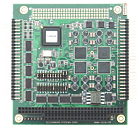 Ruby-MM-1616A
Up to 16 Channel 16-bit Analog Output PC/104 Module with Digital I/O
The Ruby-MM-1616 PC/104 module provides up to 16 channels of 16-bit resolution analog voltage or current output. The output range can be individually selected for 0-5V, 0-10V, ±5V, ±10V, 0-20mA, 4-20mA, or 0-24mA. All outputs are updated simultaneously, either with a software command or in response to an external signal. A waveform generator is available on up to 16 channels with simultaneous updating of all channels.
The board also includes 48 lines of digital I/O, 40 lines of byte-wide and 8 lines of bit-wide, two 32-bit counter/timers, and four 24-bit pulse width modulators. Other features include +5V only operation, individual DC/DC converters with filtered outputs for each DAC to supply ±15V for operation, and a six layer circuit board to bury and shield the analog signals.
Rugged Design for the Real World
Extended temperature capability of −40°C to +85°C enables the board to operate in environments with extreme temperature swings, such as vehicles or outdoor installations. In addition, the board may be custom-configured with 0-ohm resistors in place of jumpers for increased ruggedness in high-vibration environments. As with all of Diamond’s analog I/O boards, Ruby-MM-1616 utilizes a 6-layer PCB with split analog and digital power and ground planes to keep the analog outputs quiet. All analog and digital lines reset to a known state on power up or system reset to guarantee predictable behavior. Factory calibration ensures the highest possible accuracy over the lifetime of the product. The board requires only +5V from the system power supply. These features make Ruby-MM-1616’s quality and performance a leader in the market.
Analog Output Ranges
A wide selection of output ranges is selectable on Ruby-MM-1616A. Each output can have its own output range.
Simultaneous Update
All analog outputs are updated simultaneously with a single read command. This feature minimizes time skew effects when multiple channels are being used to control a single device (for example, when two channels are controlling the X-Y position on a laser). When an update command occurs, only channels with new data written to them will change; the remaining channels will maintain their current output voltage level without interruptions or glitches.
Software Support
The Ruby-MM-1616 ships with Diamond’s free Universal Driver software for C language programming under Windows 7, Windows Embedded 7, Windows XP, Linux and DOS. All major functions of the board are supported by the driver and example programs are also included. Some examples of the supported board operations are:
Analog output on single channel
Analog output on multiple channels with simultaneous update
Interrupt-driven analog outputs with internal or external trigger
Digital input, bit, byte, and word
Digital output, bit, byte, and word
Ruby-MM-1616A
Up to 16 Channel 16-bit Analog Output PC/104 Module with Digital I/O
The Ruby-MM-1616 PC/104 module provides up to 16 channels of 16-bit resolution analog voltage or current output. The output range can be individually selected for 0-5V, 0-10V, ±5V, ±10V, 0-20mA, 4-20mA, or 0-24mA. All outputs are updated simultaneously, either with a software command or in response to an external signal. A waveform generator is available on up to 16 channels with simultaneous updating of all channels.
The board also includes 48 lines of digital I/O, 40 lines of byte-wide and 8 lines of bit-wide, two 32-bit counter/timers, and four 24-bit pulse width modulators. Other features include +5V only operation, individual DC/DC converters with filtered outputs for each DAC to supply ±15V for operation, and a six layer circuit board to bury and shield the analog signals.
Rugged Design for the Real World
Extended temperature capability of −40°C to +85°C enables the board to operate in environments with extreme temperature swings, such as vehicles or outdoor installations. In addition, the board may be custom-configured with 0-ohm resistors in place of jumpers for increased ruggedness in high-vibration environments. As with all of Diamond’s analog I/O boards, Ruby-MM-1616 utilizes a 6-layer PCB with split analog and digital power and ground planes to keep the analog outputs quiet. All analog and digital lines reset to a known state on power up or system reset to guarantee predictable behavior. Factory calibration ensures the highest possible accuracy over the lifetime of the product. The board requires only +5V from the system power supply. These features make Ruby-MM-1616’s quality and performance a leader in the market.
Analog Output Ranges
A wide selection of output ranges is selectable on Ruby-MM-1616A. Each output can have its own output range.
Simultaneous Update
All analog outputs are updated simultaneously with a single read command. This feature minimizes time skew effects when multiple channels are being used to control a single device (for example, when two channels are controlling the X-Y position on a laser). When an update command occurs, only channels with new data written to them will change; the remaining channels will maintain their current output voltage level without interruptions or glitches.
Software Support
The Ruby-MM-1616 ships with Diamond’s free Universal Driver software for C language programming under Windows 7, Windows Embedded 7, Windows XP, Linux and DOS. All major functions of the board are supported by the driver and example programs are also included. Some examples of the supported board operations are:
Analog output on single channel
Analog output on multiple channels with simultaneous update
Interrupt-driven analog outputs with internal or external trigger
Digital input, bit, byte, and word
Digital output, bit, byte, and word
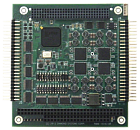 Ruby-MM-1616AP
Up to 16 Channel 16-bit Analog Output PC/104‑Plus Module with Digital I/O
The Ruby-MM-1616 PC/104 module provides up to 16 channels of 16-bit resolution analog voltage or current output. The output range can be individually selected for 0-5V, 0-10V, ±5V, ±10V, 0-20mA, 4-20mA, or 0-24mA. All outputs are updated simultaneously, either with a software command or in response to an external signal. A waveform generator is available on up to 16 channels with simultaneous updating of all channels.
The board also includes 48 lines of digital I/O, 40 lines of byte-wide and 8 lines of bit-wide, two 32-bit counter/timers, and four 24-bit pulse width modulators. Other features include +5V only operation, individual DC/DC converters with filtered outputs for each DAC to supply ±15V for operation, and a six layer circuit board to bury and shield the analog signals.
Rugged Design for the Real World
Extended temperature capability of −40°C to +85°C enables the board to operate in environments with extreme temperature swings, such as vehicles or outdoor installations. In addition, the board may be custom-configured with 0-ohm resistors in place of jumpers for increased ruggedness in high-vibration environments. As with all of Diamond’s analog I/O boards, Ruby-MM-1616 utilizes a 6-layer PCB with split analog and digital power and ground planes to keep the analog outputs quiet. All analog and digital lines reset to a known state on power up or system reset to guarantee predictable behavior. Factory calibration ensures the highest possible accuracy over the lifetime of the product. The board requires only +5V from the system power supply. These features make Ruby-MM-1616’s quality and performance a leader in the market.
Analog Output Ranges
A wide selection of output ranges is selectable on Ruby-MM-1616AP. Each output can have its own output range.
Simultaneous Update
All analog outputs are updated simultaneously with a single read command. This feature minimizes time skew effects when multiple channels are being used to control a single device (for example, when two channels are controlling the X-Y position on a laser). When an update command occurs, only channels with new data written to them will change; the remaining channels will maintain their current output voltage level without interruptions or glitches.
Software Support
The Ruby-MM-1616 ships with Diamond’s free Universal Driver software for C language programming under Windows 7, Windows Embedded 7, Windows XP, Linux and DOS. All major functions of the board are supported by the driver and example programs are also included. Some examples of the supported board operations are:
Analog output on single channel
Analog output on multiple channels with simultaneous update
Interrupt-driven analog outputs with internal or external trigger
Digital input, bit, byte, and word
Digital output, bit, byte, and word
Ruby-MM-1616AP
Up to 16 Channel 16-bit Analog Output PC/104‑Plus Module with Digital I/O
The Ruby-MM-1616 PC/104 module provides up to 16 channels of 16-bit resolution analog voltage or current output. The output range can be individually selected for 0-5V, 0-10V, ±5V, ±10V, 0-20mA, 4-20mA, or 0-24mA. All outputs are updated simultaneously, either with a software command or in response to an external signal. A waveform generator is available on up to 16 channels with simultaneous updating of all channels.
The board also includes 48 lines of digital I/O, 40 lines of byte-wide and 8 lines of bit-wide, two 32-bit counter/timers, and four 24-bit pulse width modulators. Other features include +5V only operation, individual DC/DC converters with filtered outputs for each DAC to supply ±15V for operation, and a six layer circuit board to bury and shield the analog signals.
Rugged Design for the Real World
Extended temperature capability of −40°C to +85°C enables the board to operate in environments with extreme temperature swings, such as vehicles or outdoor installations. In addition, the board may be custom-configured with 0-ohm resistors in place of jumpers for increased ruggedness in high-vibration environments. As with all of Diamond’s analog I/O boards, Ruby-MM-1616 utilizes a 6-layer PCB with split analog and digital power and ground planes to keep the analog outputs quiet. All analog and digital lines reset to a known state on power up or system reset to guarantee predictable behavior. Factory calibration ensures the highest possible accuracy over the lifetime of the product. The board requires only +5V from the system power supply. These features make Ruby-MM-1616’s quality and performance a leader in the market.
Analog Output Ranges
A wide selection of output ranges is selectable on Ruby-MM-1616AP. Each output can have its own output range.
Simultaneous Update
All analog outputs are updated simultaneously with a single read command. This feature minimizes time skew effects when multiple channels are being used to control a single device (for example, when two channels are controlling the X-Y position on a laser). When an update command occurs, only channels with new data written to them will change; the remaining channels will maintain their current output voltage level without interruptions or glitches.
Software Support
The Ruby-MM-1616 ships with Diamond’s free Universal Driver software for C language programming under Windows 7, Windows Embedded 7, Windows XP, Linux and DOS. All major functions of the board are supported by the driver and example programs are also included. Some examples of the supported board operations are:
Analog output on single channel
Analog output on multiple channels with simultaneous update
Interrupt-driven analog outputs with internal or external trigger
Digital input, bit, byte, and word
Digital output, bit, byte, and word
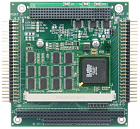 P104-GPIO96
Programmable Digital I/O PC/104-Plus Module with Customizable Personality
P104-GPIO96 is a PC/104-Plus general purpose digital I/O module integrating Diamond’s using a high-capacity PCI Express FPGA for maximum density and flexibility.
P104-GPIO96 is a programmable PC/104-Plus DIO module using a high-capacity (700K gate equivalent) PCI Express FPGA for maximum density and flexibility. The base hardware configuration features 96 digital I/O lines grouped into 12 8-bit ports. All ports have I/O buffers to protect the FPGA and feature 5V logic drive levels. The ports are organized into a combination of byte-wide, nibble-wide, and bit-wide direction control for maximum flexibility and application compatibility.
The built-in FPGA personality provides multiple configuration options. All 96 I/O lines may be used in common I/O mode; Six of these ports can be reconfigured to enable an array of additional features, including 8 32-bit up/down counter/timers with programmable input source and gate, 4 24-bit PWM circuits with 0-100% duty cycle capability and interrupt/latched mode operation.
The flash-based design enables easy field upgrades using a Diamond-provided software utility (no cable or third-party software required!) as well as custom code development. Universal Driver software support is included for Linux, Windows XP, Windows Embedded CE/Standard.
P104-GPIO96
Programmable Digital I/O PC/104-Plus Module with Customizable Personality
P104-GPIO96 is a PC/104-Plus general purpose digital I/O module integrating Diamond’s using a high-capacity PCI Express FPGA for maximum density and flexibility.
P104-GPIO96 is a programmable PC/104-Plus DIO module using a high-capacity (700K gate equivalent) PCI Express FPGA for maximum density and flexibility. The base hardware configuration features 96 digital I/O lines grouped into 12 8-bit ports. All ports have I/O buffers to protect the FPGA and feature 5V logic drive levels. The ports are organized into a combination of byte-wide, nibble-wide, and bit-wide direction control for maximum flexibility and application compatibility.
The built-in FPGA personality provides multiple configuration options. All 96 I/O lines may be used in common I/O mode; Six of these ports can be reconfigured to enable an array of additional features, including 8 32-bit up/down counter/timers with programmable input source and gate, 4 24-bit PWM circuits with 0-100% duty cycle capability and interrupt/latched mode operation.
The flash-based design enables easy field upgrades using a Diamond-provided software utility (no cable or third-party software required!) as well as custom code development. Universal Driver software support is included for Linux, Windows XP, Windows Embedded CE/Standard.
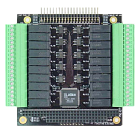 IR104-PBF
High Density Optoisolated Input + Relay Output PC/104 Module
IR104-PBF is a high-density PC/104 format digital I/O module designed for industrial applications requiring isolation between the computer and the external signals it is monitoring and controlling. This module features 20 optoisolated digital inputs and 20 relay outputs. Each input can accept both AC and DC voltages as low as 3V and as high as 24V.
The optocoupler inputs are located on a pin header at the top of the board, while the relays feature quick-disconnect terminal blocks (10 relays per block) that accept wire ranging from 14-28AWG. The board will operate in ambient temperatures ranging from −25 to +70°C.
Note: The maximum component height on this board is .492″, slightly higher than the PC/104 standard of .435″. This extra height will usually not be a problem unless the board stacked directly above the IR104-PBF has components mounted on the bottom of the board or through-hole pins that exceed .043″ in height. In this case you can mount the IR-104-PBF on the top of the stack.
Output Relays
The 20 relay outputs have SPST (form A) normally open contacts. Each relay can switch both AC and DC voltages. The relays have long lifetime (20,000,000 operations, 100,000 at full load) and quick actuation time (6ms max operate, 3ms release).Maximum load is 5A @30VDC. Relay connections are made with detachable screw terminal blocks. Each of the 2 blocks carries contacts for 10 relays.
Input Optoisolators
The 20 optoisolators can accept either AC or DC inputs ranging from 3V to 24V. Opto input connections are made with a 40-pin pin header that mates with standard ribbon cables.
IR104-PBF
High Density Optoisolated Input + Relay Output PC/104 Module
IR104-PBF is a high-density PC/104 format digital I/O module designed for industrial applications requiring isolation between the computer and the external signals it is monitoring and controlling. This module features 20 optoisolated digital inputs and 20 relay outputs. Each input can accept both AC and DC voltages as low as 3V and as high as 24V.
The optocoupler inputs are located on a pin header at the top of the board, while the relays feature quick-disconnect terminal blocks (10 relays per block) that accept wire ranging from 14-28AWG. The board will operate in ambient temperatures ranging from −25 to +70°C.
Note: The maximum component height on this board is .492″, slightly higher than the PC/104 standard of .435″. This extra height will usually not be a problem unless the board stacked directly above the IR104-PBF has components mounted on the bottom of the board or through-hole pins that exceed .043″ in height. In this case you can mount the IR-104-PBF on the top of the stack.
Output Relays
The 20 relay outputs have SPST (form A) normally open contacts. Each relay can switch both AC and DC voltages. The relays have long lifetime (20,000,000 operations, 100,000 at full load) and quick actuation time (6ms max operate, 3ms release).Maximum load is 5A @30VDC. Relay connections are made with detachable screw terminal blocks. Each of the 2 blocks carries contacts for 10 relays.
Input Optoisolators
The 20 optoisolators can accept either AC or DC inputs ranging from 3V to 24V. Opto input connections are made with a 40-pin pin header that mates with standard ribbon cables.
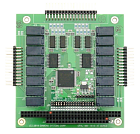 Opal-MM-1616
16 Channel Optoisolated Input & 16 Relay Output PC/104 Module
Opal-MM-1616 is a PC/104 format digital I/O module designed for industrial applications requiring isolation between the computer and the external signals it is monitoring and controlling.
The Opal-MM-1616 features 16 optoisolated digital inputs and 16 relay outputs. Each input has an input range of 0-30VDC. Opal-MM-1616 can be configured to generate an interrupt when any input changes state. Either or both banks of 8 inputs can be configured for interrupt operation. One 34-pin I/O header is used for the optoisolated inputs.
The 16 relay outputs are SPDT format (form C). Each relay has 3 contacts: Common, Normally Open, and Normally Closed. For safety and reliability, all relays are at their power-off state at power-up or system reset. Each relay can switch both AC and DC voltages. Two 26-pin I/O headers are used for the relay outputs with 8 relays on each pin header. The relays have long lifetime (10,000,000 operations) and quick actuation time (5ms max operate and release, break before make).
Diamond Systems’ Universal Driver software provides drivers and example code for use with the Opal-MM-1616. The software provides support for interrupts and enables you to integrate you own code that is called when an interrupt occurs.
Signal Isolation
Opal-MM-1616 provides isolation on its input and output lines. The board will withstand up to 500V DC or AC difference in potential between the I/O lines and the rest of the board’s circuitry. Each input and output channel on Opal-MM-1616 is completely independent and does not share any signal trace with any other channel. Therefore, every channel is isolated from every other channel.
Opal-MM-1616
16 Channel Optoisolated Input & 16 Relay Output PC/104 Module
Opal-MM-1616 is a PC/104 format digital I/O module designed for industrial applications requiring isolation between the computer and the external signals it is monitoring and controlling.
The Opal-MM-1616 features 16 optoisolated digital inputs and 16 relay outputs. Each input has an input range of 0-30VDC. Opal-MM-1616 can be configured to generate an interrupt when any input changes state. Either or both banks of 8 inputs can be configured for interrupt operation. One 34-pin I/O header is used for the optoisolated inputs.
The 16 relay outputs are SPDT format (form C). Each relay has 3 contacts: Common, Normally Open, and Normally Closed. For safety and reliability, all relays are at their power-off state at power-up or system reset. Each relay can switch both AC and DC voltages. Two 26-pin I/O headers are used for the relay outputs with 8 relays on each pin header. The relays have long lifetime (10,000,000 operations) and quick actuation time (5ms max operate and release, break before make).
Diamond Systems’ Universal Driver software provides drivers and example code for use with the Opal-MM-1616. The software provides support for interrupts and enables you to integrate you own code that is called when an interrupt occurs.
Signal Isolation
Opal-MM-1616 provides isolation on its input and output lines. The board will withstand up to 500V DC or AC difference in potential between the I/O lines and the rest of the board’s circuitry. Each input and output channel on Opal-MM-1616 is completely independent and does not share any signal trace with any other channel. Therefore, every channel is isolated from every other channel.
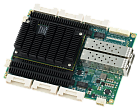 EPS-24G4X
Managed 28-Port Gigabit Ethernet Switch with 4x 10G SFP+ Ports
The EPS-24G4X is a managed Ethernet switch based on Diamond’s EPSM-10GX4 switch module. The switch implements all features of the EPSM-10GX4 Ethernet switch module, including 24x 10/100/1000Mbps copper ports and 4x 10Gbps SFI ports accessed via SFP+ sockets. Depending on the ordering configuration, the switch contains embedded software supporting Layer 2 switching, Layer 3 routing/switching, and optional IEEE1588 PTP operation.
Two software packages are available, Layer 2+ switching and Layer 3 routing/switching. In addition, IEEE-1588 precision time protocol support is available with a minor modification to support an external precision clock circuit and 1pps signal source provided by the carrier board. All software features are manageable via a GUI web interface accessible over any port, as well as with a command language accessed via a built-in RS-232 port. Customer branding is available to put your logo / color scheme / part numbers on the GUI and serial interface.
EPS-24G4X is designed specifically to meet the challenges of vehicle and other rugged environments, with its −40/+85°C operating temperature range, 50% thicker PCB, latching I/O connectors, and its MIL-STD-202G shock/vibration resistance. A wide-range input power supply with built-in transient protection provides compatibility with a range of industrial and vehicle power supplies. The board also forms the heart of Diamond’s SabreNet-24000 rugged Ethernet switch. Cooling for EPS-24G4X is provided via two heat sinks: a low-profile heat sink between the carrier board and the EPSM module and a taller heat sink for the EPSM module.
The EPS-24G4X is included as part of the EPSM-10GX4 development kit. Schematics and bill of materials are included to simplify the development of custom advanced Ethernet switching solutions based on the EPSM‑10GX4 module.
Embedded Software
The table below shows some of the more popular features available.
Layer 2+ software highlights include the following:
8K MAC addresses and 4K VLANs (IEEE 802.1Q)
8K IPv4 and IPv6 multicast group support
Jumbo frame support at all speeds
Flexible link aggregation support based on Layer-2 through Layer-4 information (IEEE 802.3ad)
Multicast and broadcast storm control, as well as flooding control
Rapid Spanning Tree protocol (RSTP) and MSTP
Multiple protocol support: IEEE 802.1d, IEEE 802.1w, IEEE 802.1s, and IEEE 802.1X
8 priorities and 8 QoS queues per port with scheduling
Layer3 software additional highlights:
Hardware- and software-based IPv6 L3 static routing
RFC 2328 OSPFv2 dynamic routing
IEEE 1588 precision time protocol (PTP)
RADIUS accounting
Port and Queue policers
EPS-24G4X
Managed 28-Port Gigabit Ethernet Switch with 4x 10G SFP+ Ports
The EPS-24G4X is a managed Ethernet switch based on Diamond’s EPSM-10GX4 switch module. The switch implements all features of the EPSM-10GX4 Ethernet switch module, including 24x 10/100/1000Mbps copper ports and 4x 10Gbps SFI ports accessed via SFP+ sockets. Depending on the ordering configuration, the switch contains embedded software supporting Layer 2 switching, Layer 3 routing/switching, and optional IEEE1588 PTP operation.
Two software packages are available, Layer 2+ switching and Layer 3 routing/switching. In addition, IEEE-1588 precision time protocol support is available with a minor modification to support an external precision clock circuit and 1pps signal source provided by the carrier board. All software features are manageable via a GUI web interface accessible over any port, as well as with a command language accessed via a built-in RS-232 port. Customer branding is available to put your logo / color scheme / part numbers on the GUI and serial interface.
EPS-24G4X is designed specifically to meet the challenges of vehicle and other rugged environments, with its −40/+85°C operating temperature range, 50% thicker PCB, latching I/O connectors, and its MIL-STD-202G shock/vibration resistance. A wide-range input power supply with built-in transient protection provides compatibility with a range of industrial and vehicle power supplies. The board also forms the heart of Diamond’s SabreNet-24000 rugged Ethernet switch. Cooling for EPS-24G4X is provided via two heat sinks: a low-profile heat sink between the carrier board and the EPSM module and a taller heat sink for the EPSM module.
The EPS-24G4X is included as part of the EPSM-10GX4 development kit. Schematics and bill of materials are included to simplify the development of custom advanced Ethernet switching solutions based on the EPSM‑10GX4 module.
Embedded Software
The table below shows some of the more popular features available.
Layer 2+ software highlights include the following:
8K MAC addresses and 4K VLANs (IEEE 802.1Q)
8K IPv4 and IPv6 multicast group support
Jumbo frame support at all speeds
Flexible link aggregation support based on Layer-2 through Layer-4 information (IEEE 802.3ad)
Multicast and broadcast storm control, as well as flooding control
Rapid Spanning Tree protocol (RSTP) and MSTP
Multiple protocol support: IEEE 802.1d, IEEE 802.1w, IEEE 802.1s, and IEEE 802.1X
8 priorities and 8 QoS queues per port with scheduling
Layer3 software additional highlights:
Hardware- and software-based IPv6 L3 static routing
RFC 2328 OSPFv2 dynamic routing
IEEE 1588 precision time protocol (PTP)
RADIUS accounting
Port and Queue policers
